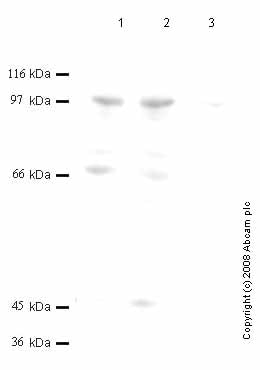Anti-DPP9 antibody - Catalytic domain (ab42080)
Key features and details
- Rabbit polyclonal to DPP9 - Catalytic domain
- Suitable for: ICC/IF, WB, IHC-P
- Reacts with: Cow, Human
- Isotype: IgG
Overview
-
Product name
Anti-DPP9 antibody - Catalytic domain
See all DPP9 primary antibodies -
Description
Rabbit polyclonal to DPP9 - Catalytic domain -
Host species
Rabbit -
Specificity
This antibody recognises all three forms of DPP9. This antibody does not recognise other DPP family members. -
Tested applications
Suitable for: ICC/IF, WB, IHC-Pmore details -
Species reactivity
Reacts with: Cow, Human -
Immunogen
Synthetic peptide corresponding to Human DPP9.
(Peptide available asab44599)
Properties
-
Form
Liquid -
Storage instructions
Shipped at 4°C. Upon delivery aliquot and store at -20°C. Avoid freeze / thaw cycles. -
Storage buffer
Preservative: 0.05% Sodium azide
Constituents: PBS, 50% Glycerol, 2.9% Sodium chloride -
 Concentration information loading...
Concentration information loading... -
Purity
Immunogen affinity purified -
Clonality
Polyclonal -
Isotype
IgG -
Research areas
Images
-
All lanes : Anti-DPP9 antibody - Catalytic domain (ab42080) at 1/1000 dilution
Lane 1 : Cell media from human prostate cancer DU145 cells (treated with SF)
Lane 2 : Cell media from human prostate cancer DU145 cells (treated with RA)
Lane 3 : Cell media from human prostate cancer DU145 cells (treated with IL1-beta)
Predicted band size: 98 kDa
-
 Immunohistochemistry (Formalin/PFA-fixed paraffin-embedded sections) - Anti-DPP9 antibody - Catalytic domain (ab42080)Ab42080 staining Human normal placenta. Staining is localised to the membrane and cytoplasm.
Immunohistochemistry (Formalin/PFA-fixed paraffin-embedded sections) - Anti-DPP9 antibody - Catalytic domain (ab42080)Ab42080 staining Human normal placenta. Staining is localised to the membrane and cytoplasm.
Left panel: with primary antibody at 4 ug/ml. Right panel: isotype control.
Sections were stained using an automated system DAKO Autostainer Plus , at room temperature. Sections were rehydrated and antigen retrieved with the Dako 3-in-1 AR buffers EDTA pH 9.0 in a DAKO PT Link. Slides were peroxidase blocked in 3% H2O2 in methanol for 10 minutes. They were then blocked with Dako Protein block for 10 minutes (containing casein 0.25% in PBS) then incubated with primary antibody for 20 minutes and detected with Dako Envision Flex amplification kit for 30 minutes. Colorimetric detection was completed with diaminobenzidine for 5 minutes. Slides were counterstained with Haematoxylin and coverslipped under DePeX. Please note that for manual staining we recommend to optimize the primary antibody concentration and incubation time (overnight incubation), and amplification may be required. -
 Immunohistochemistry (Formalin/PFA-fixed paraffin-embedded sections) - Anti-DPP9 antibody - Catalytic domain (ab42080) This image is a courtesy of an Abreview submitted by Veronique Dubois
Immunohistochemistry (Formalin/PFA-fixed paraffin-embedded sections) - Anti-DPP9 antibody - Catalytic domain (ab42080) This image is a courtesy of an Abreview submitted by Veronique Duboisab42080 staining DPP9 in bovine testicular tissue section by Immunohistochemistry (Formalin/PFA-fixed paraffin-embedded sections). Tissue underwent paraformaldehyde fixation before heat mediated antigen retrieval in Tris/EDTA buffer pH 9.0 and then the sample was blocked with 3% hydrogen peroxide in TBS for 10 minutes at 25°C. The sections were treated for 10 min with 3% H2O2 in TBS to block endogenous peroxidase activity and incubated subsequently for 30 min with 10% nonimmune goat serum to minimize nonspecific antibody binding. The primary antibody (1/50) was incubated with sample in TBS, 0.3% Triton X-100, 0.1 % BSA for 16 hours at 4°C. A Biotin conjugated goat polyclonal to rabbit IgG was used at dilution 1/200 as secondary antibody.
-
ICC/IF image of ab42080 stained Hek293 cells. The cells were 100% methanol fixed (5 min) and then incubated in 1%BSA / 10% normal goat serum / 0.3M glycine in 0.1% PBS-Tween for 1h to permeabilise the cells and block non-specific protein-protein interactions. The cells were then incubated with the antibody (ab42080, 1µg/ml) overnight at +4°C. The secondary antibody (green) was Alexa Fluor® 488 goat anti-rabbit IgG (H+L) used at a 1/1000 dilution for 1h. Alexa Fluor® 594 WGA was used to label plasma membranes (red) at a 1/200 dilution for 1h. DAPI was used to stain the cell nuclei (blue) at a concentration of 1.43µM.













